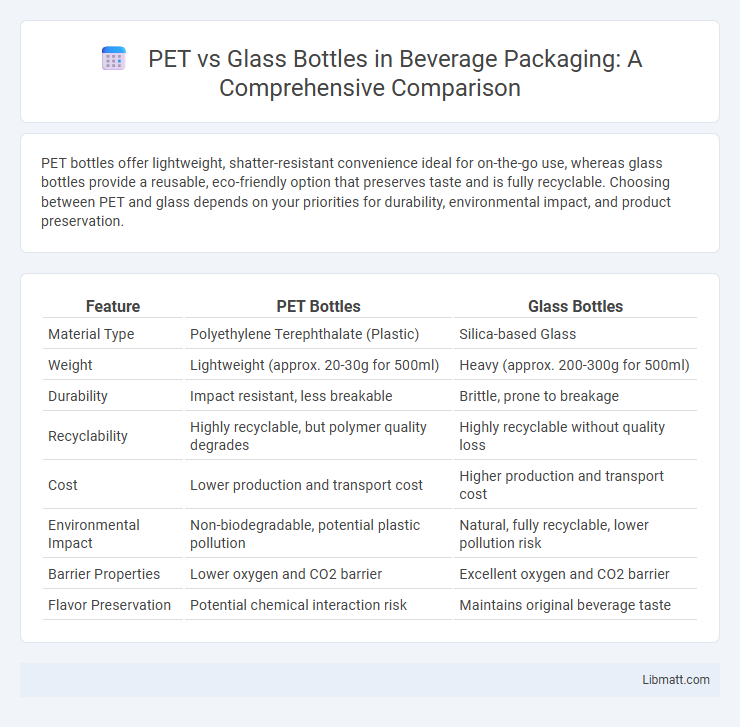PET bottles offer lightweight, shatter-resistant convenience ideal for on-the-go use, whereas glass bottles provide a reusable, eco-friendly option that preserves taste and is fully recyclable. Choosing between PET and glass depends on your priorities for durability, environmental impact, and product preservation.
Table of Comparison
| Feature | PET Bottles | Glass Bottles |
|---|---|---|
| Material Type | Polyethylene Terephthalate (Plastic) | Silica-based Glass |
| Weight | Lightweight (approx. 20-30g for 500ml) | Heavy (approx. 200-300g for 500ml) |
| Durability | Impact resistant, less breakable | Brittle, prone to breakage |
| Recyclability | Highly recyclable, but polymer quality degrades | Highly recyclable without quality loss |
| Cost | Lower production and transport cost | Higher production and transport cost |
| Environmental Impact | Non-biodegradable, potential plastic pollution | Natural, fully recyclable, lower pollution risk |
| Barrier Properties | Lower oxygen and CO2 barrier | Excellent oxygen and CO2 barrier |
| Flavor Preservation | Potential chemical interaction risk | Maintains original beverage taste |
Introduction to PET and Glass Bottles
PET bottles, made from polyethylene terephthalate, are lightweight, shatter-resistant, and highly recyclable, commonly used for beverages and food storage. Glass bottles, crafted from silica-based materials, offer superior chemical inertness and recyclability, maintaining product purity without leaching contaminants. Both materials serve key roles in packaging, with PET favored for convenience and durability, while glass is preferred for its premium appearance and environmental sustainability.
Material Composition and Manufacturing
PET bottles are made from polyethylene terephthalate, a lightweight, durable polymer synthesized through polymerization of ethylene glycol and terephthalic acid, offering excellent impact resistance and clarity. Glass bottles are composed primarily of silica sand, soda ash, and limestone, melted at high temperatures to form a rigid, non-porous container with superior chemical inertness and recyclability. Your choice between PET and glass impacts sustainability and product protection due to differences in manufacturing energy consumption and material properties.
Environmental Impact Comparison
PET bottles generate lower greenhouse gas emissions during production compared to glass bottles, owing to their lighter weight and reduced energy consumption in transportation. However, PET's environmental impact is heightened by challenges in recycling efficiency and the persistence of microplastics in ecosystems. Glass bottles, although heavier and more energy-intensive to transport, are infinitely recyclable without quality loss, making them a more sustainable option when recycled effectively.
Durability and Strength Differences
PET bottles offer superior durability and impact resistance compared to glass bottles, making them less prone to breakage during transportation and handling. Glass bottles, while heavier and more fragile, provide better resistance to pressure and maintain their structural integrity under high temperatures. Your choice depends on whether you prioritize lightweight durability or the rigidity and heat resistance of glass containers.
Weight and Portability Factors
PET bottles weigh significantly less than glass bottles, making them more convenient for transport and everyday use. The lightweight nature of PET reduces shipping costs and carbon footprint during distribution. Glass bottles, although heavier and less portable, offer superior recyclability and can provide a premium feel in packaging.
Safety and Chemical Leaching Concerns
PET bottles are generally safe for everyday use but may release trace amounts of antimony and phthalates under high temperatures or prolonged storage, raising chemical leaching concerns. Glass bottles offer superior chemical inertness, preventing toxins from leaching into beverages, making them a safer option for long-term storage. Choosing glass can better protect Your health by reducing exposure to potentially harmful chemicals often associated with plastic packaging.
Recyclability and Circular Economy
PET bottles offer high recyclability through established collection and processing systems, allowing materials to be efficiently recovered and reused in new products. Glass bottles support a robust circular economy due to their infinite recyclability without quality loss, promoting closed-loop recycling and reducing raw material extraction. You can contribute to sustainability by choosing packaging that aligns with local recycling infrastructure and circular economy principles.
Cost Analysis: Production and Transportation
PET bottles offer significant cost advantages in production due to lower material and manufacturing expenses compared to glass bottles, which require more energy-intensive processes and higher raw material costs. Transportation costs also favor PET because its lightweight nature reduces fuel consumption and freight charges, enhancing overall supply chain efficiency. Your choice of container can impact budget optimization, with PET providing more economical solutions in both production and logistics.
Beverage Preservation and Shelf Life
PET bottles offer excellent oxygen barrier properties that help maintain beverage freshness and carbonation, extending shelf life for carbonated drinks up to several months. Glass bottles provide superior impermeability and inertness, preventing flavor alteration and preserving beverage quality for significantly longer durations, often exceeding one year. Both materials ensure effective preservation, but glass is preferred for long-term storage due to its enhanced protection against oxygen and chemical interactions.
Consumer Preferences and Market Trends
Consumer preferences increasingly favor PET bottles due to their lightweight, durability, and convenience for on-the-go lifestyles compared to glass bottles. Market trends reveal a growing demand for sustainable packaging, prompting innovations in recyclable PET materials while some consumers continue to prefer glass for its perceived purity and premium feel. Understanding your audience's values around convenience, sustainability, and product quality is essential in choosing between PET and glass bottles.
PET vs glass bottles Infographic

 libmatt.com
libmatt.com